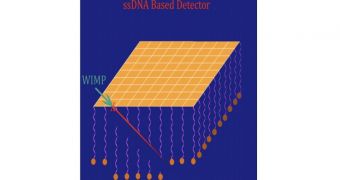Building a detector to identify Weakly-Interacting Massive Particles (WIMP) is not an easy task. Physicists have been at it for decades, and yet no one has ever been able to discover these basic constituents of dark matter. Now, a team of scientists plans to create a detector out of DNA.
They believe that the instrument will be able to detect WIMP with a level of accuracy unavailable to any other technology in use today. There is no shortage of material to be detected, either. Astrophysicists believe the Sun is currently traveling through a dense cloud of dark matter.
In fact, our entire solar system is bathed in the stuff. The Sun is currently heading towards the constellation Cygnus (the Swan). Therefore, scientists believe, dark matter is all around, as demonstrated by the gravitational effect it has on baryonic (regular) matter.
WIMP are believed to be their own antiparticles. However, theory holds that they interact with each other only on extremely rare occasions. When this happens, the particles annihilate each other, releasing large amounts of energy, Technology Review reports.
There is also another issue with finding dark matter. Based on the solar system's heading, we should see more of the stuff coming from the direction of Cygnus. Therefore, experts need to build a directional dark matter detector (DDMD), which is even more difficult than constructing a regular one.
Experts at the University of Michigan in Ann Arbor (UMAA) and the Harvard University, together with other colleagues, recently proposed the construction of DDMD that relies on the use of thin gold sheets, each featuring a large number of single-stranded DNA dangling from it.
The strands are all identical, except that they feature a marker at their free end, revealing their position on the gold sheet. When a WIMP crashes into the foil, it strikes a gold atom, and removes it from the material, sending it through the DNA strands below.
As it travels, the nucleus rips apart multiple DNA strands, leaving a discernible mark behind. The pieces of strand that are ripped apart fall into a collecting tray, which is removed every hour. Using a polymerase chain reaction, experts then amplify the signals, revealing the course of the nucleus.
One of the main advantages of the new system is that the exact path of the original WIMP can be established with nanometer resolution, something that is just not possible with other techniques.
Additional details on the methods are available online in a paper called “New Dark Matter Detectors using DNA for Nanometer Tracking,” which was published in the journal arXiv.

 14 DAY TRIAL //
14 DAY TRIAL //